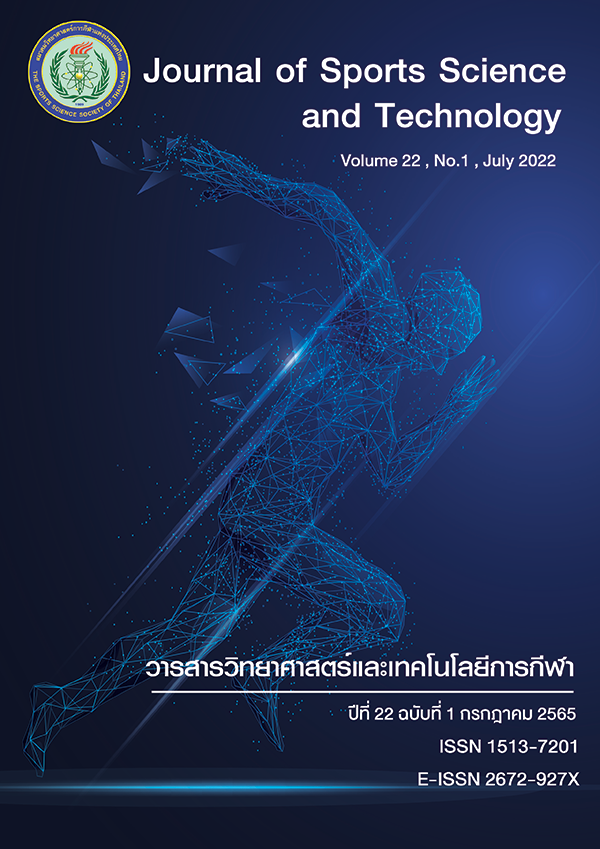STUDY OF VERTICAL GROUND REACTION FORCE IN DIFFERENT VARIATIONS OF PUSH-UP IN HEALTHY MEN
DOI:
https://doi.org/10.14456/jsst.2022.2Keywords:
kinetic, push-up, kinetic for push-up, Vertical Ground Reaction ForceAbstract
The aim of this study was to determine the kinetic variation analysis between both hands during different variation of push-ups (standard push-up, balance boards push-up, and suspension push-up). Methodology: Seventeen healthy, right handed males were the subjects of this study, whose mean age are 22.47± 0.87 years mean height ±SD= 173.82 ± 3.11 cm, and mean weight ±SD = 70.80 ± 8.55 kg. This research was a single group, repeated measures design. On the day of testing, researchers informed the participants about the general information of the research and consent forms were signed. The subjects were then asked to warm up for 10 minutes by (1) riding a bicycle and (2) doing general stretching for five minutes each, (3) subjects drew the push-up variation, then (4) familiarizes themselves with the push-up variation. Then (5) subject did the push-up three times consecutively within three seconds controlled by the metronome. After that (6) the ground reaction force in both hands was recorded. (7) Three trials with 10-minute rest between trial were conducted and drew another push-up variation for the next trial. After trial session, (8) subjects cooled down and stretched. Vertical ground reaction force was recorded by two force platforms for each hand. One-way ANOVA with repeated measure was used to calculate for means and standard deviation; and LSD post hoc test and Friedman test were used to analyze the data. The statistically significant was at p < 0.05 level. Results: No significant differences in peak ground reaction force between left hand, right hand and both hands were found among standard push-up, balance boards push-up and suspension push-up. Conclusion: The kinetic analysis resulted in the present study showing that the indicated ground reaction force was not related to the different push-up variation. However, the findings can be used for development and inventing new innovation for push-up training in the future research.
(Journal of Sports Science and Technology 2022; 22 (1): 25-36)
(Received: 17 September 2021, Revised: 2 February 2022, Accepted: : 17 February 2022)
Keywords: Kinetic/ Push-Up/ Kinetic for Push-Up/ Vertical Ground Reaction Force
*Corresponding author: Natthaphol PHEWKHAM
Faculty of Allied Health Sciences, Thammasat University, Pathum-thani, THAILAND
Email: Tomt9113@gmail.com
References
2. Contreras B, Schoenfeld B, Mike J, Tiryaki-Sonmez R, Cronin J, Vaino E. The Biomechanics of the Push-up. Strength and Conditioning Journal. 2012;34:41-6.
3. Kaminsky LA, American College of Sports M, American College of Sports M. ACSM's health-related physical fitness assessment manual. Philadelphia: Wolters Kluwer Health/Lippincott Williams & Wilkins Health; 2010.
4. Ebben WP, Wurm B, VanderZanden TL, Spadavecchia ML, Durocher JJ, Bickham CT, et al. Kinetic Analysis of Several Variations of Push-Ups. The Journal of Strength & Conditioning Research. 2011;25(10).
5. Moore LH, Tankovich MJ, Riemann BL, Davies GJ. Kinematic Analysis of Four Plyometric Push-Up Variations. Int J Exerc Sci. 2012;5(4):334-43.
6. Koch J, Riemann B, Davies G. Ground Reaction Force Patterns in Plyometric Push-Ups. Journal of strength and conditioning research / National Strength & Conditioning Association. 2011;26:2220-7.
7. Snarr RL, Esco MR. Electromyographic comparison of traditional and suspension push-ups. Journal of human kinetics. 2013;39:75-83.
8. Calatayud J, Borreani S, Colado JC, Martín FF, Rogers ME, Behm DG, et al. Muscle Activation during Push-Ups with Different Suspension Training Systems. Journal of sports science & medicine. 2014;13(3):502-10.
9. Phewkham N, Hirunrat S, Ajjimaporn A, Boonnuch C, editors. COMPARISON OF THE ELECTROMYOGRAPHY DURING PUSH-UP EXERCISE WITH THREE DIFFERENT CONDITIONS IN HEALTHY ADULTS2016.
10. Ebben WP, Wurm B, VanderZanden TL, Spadavecchia ML, Durocher JJ, Bickham CT, et al. Kinetic analysis of several variations of push-ups. J Strength Cond Res. 2011;25(10):2891-4.
11. Mayer F, Schlumberger A, Cingel R, Henrotin Y, Laube W, Schmidtbleicher D. Training and testing in open versus closed kinetic chain. Isokinetics and Exercise Science. 2003;11:181-7.
12. Youdas J, Budach B, Ellerbusch J, Stucky C, Wait K, Hollman J. Comparison of Muscle-Activation Patterns During the Conventional Push-Up and Perfect· Pushup™ Exercises. Journal of strength and conditioning research / National Strength & Conditioning Association. 2010;24:3352-62.
13. García-Massó X, Colado JC, González LM, Salvá P, Alves J, Tella V, et al. Myoelectric activation and kinetics of different plyometric push-up exercises. J Strength Cond Res. 2011;25(7):2040-7.
14. Suprak D, Dawes J, Stephenson M. The Effect of Position on the Percentage of Body Mass Supported During Traditional and Modified Push-up Variants. Journal of strength and conditioning research / National Strength & Conditioning Association. 2010;25:497-503.
15. Smith JP, Kernozek TW, Kline DE, Wright GA. Kinematic and kinetic variations among three depth jump conditions in male NCAA division III athletes. J Strength Cond Res. 2011;25(1):94-102.
16. Mierǂ C, Amasay T, Capehart S, Heather. Differences between Men and Women in Percentage of Body Weight Supported during Push-up Exercise. Int J Exerc Sci. 2014;7:161-8.
17. Hinshaw T, Stephenson M, Sha Z, Dai B. The Effect of External Loading on Force and Power Production during Plyometric Push-ups. Journal of Strength and Conditioning Research. 2017;32:1.






